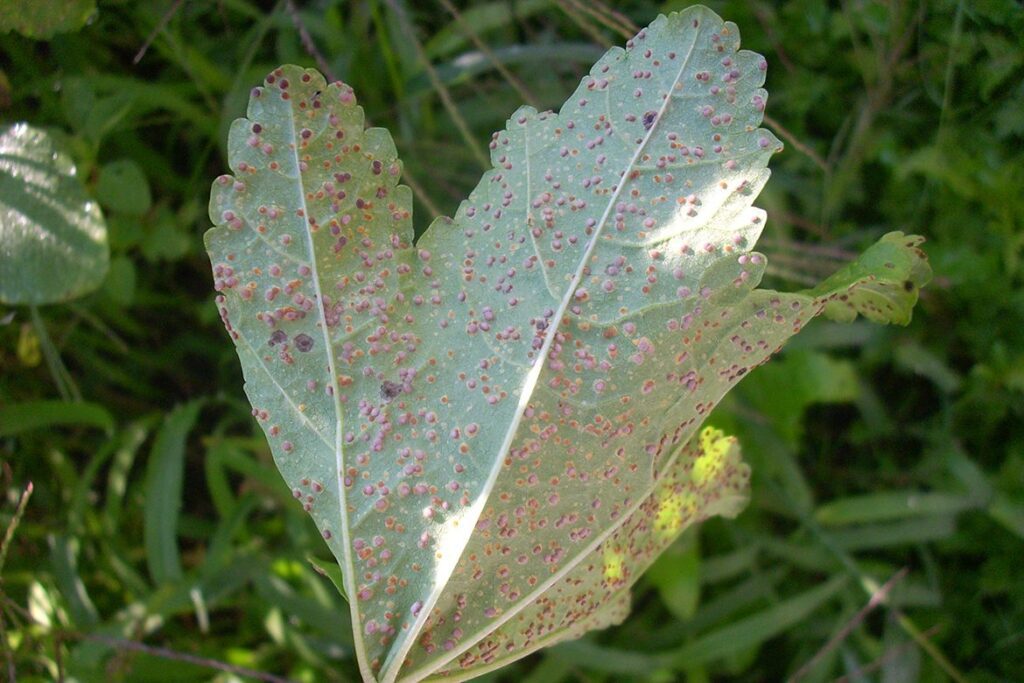The summer heat favors the spread of fungal diseases in the garden, because fungi love a warm and humid climate. There are an incredible number of fungal diseases that plague our garden plants, such as gray mold rot, black rot, leaf spot fungi, rust fungi, wilt diseases, scab, and powdery and downy mildew. No matter which of these fungi appear in your garden, the control measures are always the same.
Contents
First step in fungal diseases in the garden: remove infested plant parts.
Fungal diseases usually become visible through noticeable changes on the leaves. For example, brown spots and orange pustules appear or the leaves turn yellowish and begin to wilt. If you notice a fungal infestation in time, it is sometimes sufficient to remove and dispose of the affected parts of the plant. If necessary, complete pruning can be done to stimulate healthy new growth. It is then best to treat the new shoots with a tonic (see below) so that the fungus does not strike again immediately. Even if the fungi have already taken hold, there are non-toxic DIY sprays to keep them at bay (see below). Garden supply stores also offer many environmentally friendly preparations that are approved for organic cultivation.
But be careful – not all leaf discoloration has to be a fungus, however: It can also indicate a poor supply of certain nutrients (e.g., potassium deficiency or magnesium deficiency). Likewise, an oversupply of nutrients can cause leaf discoloration. However, such problems rarely occur when well-dosed fertilizer is applied with compost or plant liquid manure.
Precautions against fungi in sensitive crops
Some plants are naturally particularly susceptible to fungal diseases. Tomatoes, for example, usually struggle with blight. Mallows and hollyhocks usually get mallow rust (see cover photo). Strawberries are susceptible to gray mold rot, and lemon balm catches leaf spot disease every summer. Cucumbers, spinach and zucchini, but also marigolds get powdery mildew particularly often.
Such susceptible plants, which have the same fungal problems every year, should not be placed in the shade and planted too densely. This is because it leads to increased moisture, which significantly promotes fungal attack. Therefore, pay attention to sufficient planting distances, so the plants can always dry quickly after a rain! Watering such plants is best only directly at the root, because showering the whole plant increases the risk of fungus. In addition, fungi prefer plant tissue that is soft and swollen from excessive nitrogen fertilization, so you may want to hold off on fertilizing. Unfortunately, many home gardeners tend to over-fertilize their plants.
Strengthen plants against fungal diseases in the garden
They can spray sensitive plants with horsetail preparations or algae extracts as a preventative measure. This strengthens the cell tissue and makes it more difficult for the fungus to take hold. However, such preventatives and tonics as horsetail broth will not help if the fungus is already there.
This is how you make the broth: boil the horsetail, which contains silicic acid, in water for about half an hour. You will need 500 g of fresh field horsetail (or 100 g dried) to 5 liters of water. You then spray the horsetail broth diluted 1:5 in a pump sprayer on the plants. Nettle liquid manure can also be used diluted 1:10 as a tonic against fungi. The nettle liquid manure is not poured over the plant, but only applied to the root area.
Biological fungal sprays make your own
If the fungus is already visible, more powerful means are required. On the one hand, there are numerous commercially available preparations based on sulfur or lecithin, as well as water glass. Water glass is the silica-rich sodium silicate.
But there are also home remedies that work well: these include sprays of garlic, onion and wild garlic, as well as lavender. For example, you can make a fungicidal tea from 40 g of fresh finely chopped onion or garlic, which you pour over 5 liters of hot water and let steep for about 1 hour. The cooled tea is then sprayed undiluted over the plants once a week. Be sure to wet the undersides of the leaves as well, as they are especially susceptible.
You can make a simple and inexpensive fungal spray using 4 parts water and one part low-fat fresh milk (8:1 for whole milk!). Then, in 5 liters of this mixture, mix three drops of lavender essential oil or tea tree oil as a substitute. If possible, do not use UHT milk in this process! Spray the leaves of the plants with a fine spray nozzle above and below at least once a week. It is best to carry out spraying in the morning when the sky is overcast. By the way, it also helps against aphid infestation.
In principle, with biological sprays, before spraying, remove all shoots and leaves visibly affected with fungus.


